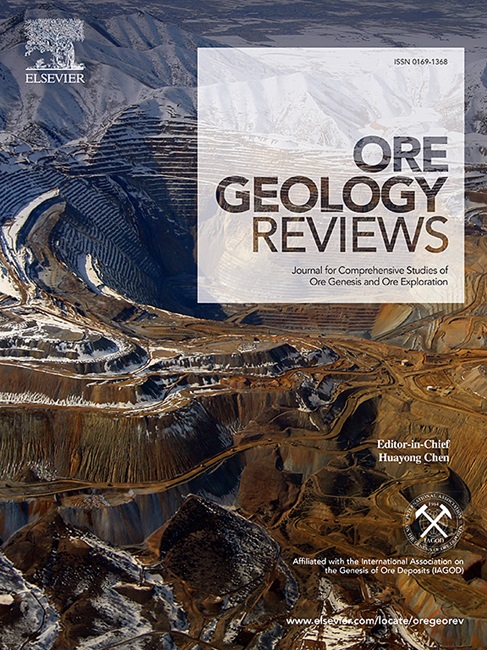In situ U–Pb dating of dolomite: Reliable ages for sandstone-hosted uranium deposits in the southern Songliao Basin, NE China
IF 3.2
2区 地球科学
Q1 GEOLOGY
引用次数: 0
Abstract
Previously, the ages of U mineralization in sandstone-hosted uranium deposits have not been adequately constrained due to the absence of suitable minerals for precise radiometric dating. To ascertain the mineralogenetic epoch and origin of the ore-forming fluids in the sandstone-hosted uranium deposits within the southern Songliao Basin of northeastern China, we conducted U–Pb dating, major and trace element analyses, and Sr isotope analyses on carbonate minerals taken from the sandstone. In this study, we present a novel U–Pb age of 92.5 ± 6.9 Ma (MSWD = 0.56) for calcite nodules, which is interpreted as the depositional age of the target formation hosting the ore. The age of the main mineralization stage is constrained by two types of high uranium carbonate minerals: the dolomite coexists with siderite and recrystallized framboidal pyrite, whereascoarse-grained ankerite occurs with dawsonite enveloping dolomite. The dolomite vein yields an age of ∼60 Ma (62.8 ± 0.5 Ma, MSWD = 2.7; 60.0 ± 0.4 Ma, MSWD = 6.4), the coarse-grained ankerite may be contemporaneous with the widely distributed diabase with an age of ∼40 Ma, which is interpreted two U mineralization ages. The ∼92 Ma calcite nodules are characterized by low U and U/Th ratios and relatively flat REE distribution patterns, and the high 87Sr/86Sr ratios (0.7109–0.7327) and the dispersed trace element composition can be attributed to fluid–rock interactions. In contrast, dolomite veins with an age of approximately 60 Ma exhibit elevated MnO and Y/Ho ratios, as well as patterns enriched in heavy rare earth elements (HREEs); the 87Sr/86Sr ratios range from 0.7066 to 0.7092, indicating their association with hydrocarbon seep-related carbonates of microbial origin. The coarse-grained ankerite, which has high REE + Y values and hump-shaped, MREE-enriched patterns with low Y/Ho ratios and negligible to positive Eu anomalies, combined with the spatial relationship between the ankerite-bearing sandstone sample and diabase, indicates that the ankerite is the product of hydrothermal processes. This ∼60 Ma dolomite presents initial evidence indicating that the Hulihai deposit is contemporaneous with a significant regional tectonic inversion event and preceded or coincided with hydrocarbon fluid activity in the southern Songliao Basin. Based on the spatial and temporal correlations, it is plausible that both the Palaeocene (∼60 Ma) tectonic reversal event and the Eocene hydrothermal event (∼40 Ma) were causally linked to sandstone-hosted uranium deposits in the southern Songliao Basin. The present study demonstrates the robustness of in situ carbonate mineral U–Pb dating as a valuable tool for geochronological investigations pertaining to sandstone-hosted uranium deposits.

白云岩原位 U-Pb 定年:中国东北松辽盆地南部砂岩型铀矿床的可靠年龄
此前,由于缺乏合适的矿物进行精确的放射性测年,砂岩型铀矿床的铀成矿时代一直没有得到充分的确定。为了确定中国东北松辽盆地南部砂岩型铀矿床的成矿时代和成矿流体的来源,我们对取自砂岩的碳酸盐矿物进行了铀-铅年代测定、主要元素和微量元素分析以及锶同位素分析。在这项研究中,我们提出了方解石结核的新U-Pb年龄为92.5 ± 6.9 Ma (MSWD = 0.56),该年龄被解释为矿石所在目标层的沉积年龄。主要成矿阶段的年龄受到两种类型的高铀碳酸盐矿物的制约:白云石与菱铁矿和重结晶框黄铁矿共存,而粗粒黄铁矿则与包覆白云石的道逊石共存。白云岩脉的年代为 60 Ma(62.8 ± 0.5 Ma,MSWD = 2.7;60.0 ± 0.4 Ma,MSWD = 6.4),粗粒闪长岩可能与广泛分布的辉长岩同时代,其年代为 40 Ma,可解释为两个铀矿化年代。∼92 Ma方解石结核具有低U和U/Th比值和相对平缓的REE分布模式,高87Sr/86Sr比值(0.7109-0.7327)和分散的微量元素组成可归因于流体-岩石相互作用。与此相反,年龄约为 60 Ma 的白云岩脉显示出较高的 MnO 和 Y/Ho 比值,以及富含重稀土元素(HREEs)的形态;87Sr/86Sr 比值范围在 0.7066 至 0.7092 之间,表明它们与源于微生物的碳酸盐烃渗流有关。粗粒闪长岩的 REE + Y 值高,呈驼峰状,MREE 富集,Y/Ho 比值低,Eu 异常可忽略不计,甚至为正,结合含闪长岩砂岩样本与辉绿岩之间的空间关系,表明闪长岩是热液过程的产物。这块∼60 Ma的白云岩提供了初步证据,表明胡里海矿床与一个重要的区域构造反转事件同时发生,并先于或与松辽盆地南部的烃流体活动相吻合。根据时空相关性,古新世(∼60Ma)构造逆转事件和始新世热液事件(∼40Ma)与松辽盆地南部砂岩型铀矿床存在因果关系。本研究证明了原位碳酸盐矿物U-Pb定年是砂岩型铀矿床地质年代研究的重要工具。
本文章由计算机程序翻译,如有差异,请以英文原文为准。
求助全文
约1分钟内获得全文
求助全文
来源期刊

Ore Geology Reviews
地学-地质学
CiteScore
6.50
自引率
27.30%
发文量
546
审稿时长
22.9 weeks
期刊介绍:
Ore Geology Reviews aims to familiarize all earth scientists with recent advances in a number of interconnected disciplines related to the study of, and search for, ore deposits. The reviews range from brief to longer contributions, but the journal preferentially publishes manuscripts that fill the niche between the commonly shorter journal articles and the comprehensive book coverages, and thus has a special appeal to many authors and readers.
 求助内容:
求助内容: 应助结果提醒方式:
应助结果提醒方式:


